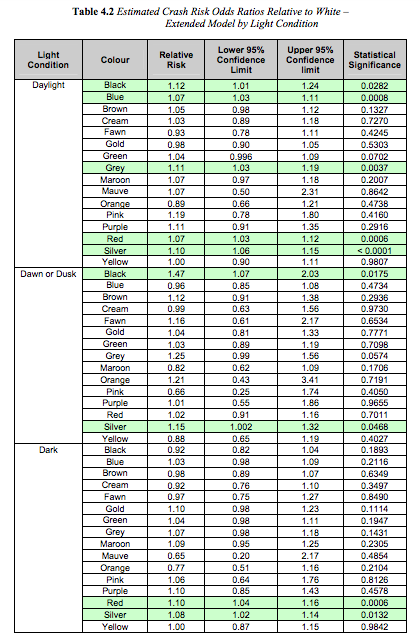While the colour of your next vehicle can be one of the most difficult decisions to make for some vehicle purchasers, this decision can directly affect the safety of your vehicle. The most comprehensive study of this topic to date shows that there is a direct association between certain vehicle colours and the likelihood of that vehicle being involved in a crash.
Research undertaken by Stuart Newstead and Angelo D’Elia of the Monash University Accident Research Centre (MUARC) has shown that vehicles painted with what they deemed as ‘low visibility’ colours have a higher risk of crashing. MUARC also identified a link between vehicle colour and crash severity, meaning low visibility vehicles are at a higher risk of being involved in severe vehicle crashes.
MUARC released a study in 2007 named “An Investigation into the Relationship between Vehicle Colour and Crash Risk” that produced the most comprehensive analysis of the correlation between vehicle colour and crash risk available today.
The study examined the police reported crash data from Victoria and Western Australia (the only two states that included vehicle colour in their crash data) between 1987-2004, which was assembled for the Used Car Safety Ratings. The data used for the study included 102’559 crashes causing driver injury in Victoria, and 752’699 crashes that resulted in injury or a vehicle being towed away in Western Australia.
The data was categorised by vehicle type, light conditions and jurisdiction of crash by reporting police officers to adjust for factors that may otherwise skew the results. This allowed for the study to determine crash risk associated with vehicle colour within these differing factors and conditions (such as association between vehicle colours and crash risk in differing light conditions etc.)
The analysis of the crash report data found a “clear statistically significant relationship between vehicle colour and crash risk.” (Pg. vii) The statistics found that in varying conditions, the colours black, blue, green, grey, red and silver had a statistically significant higher crash risk compared to the colour white. The research also did not find a statistically significant lower crash risk for any colour compared to white.

MUARC’s overall crash results for colours compared to white. Statistical significance must be 0.05 or lower to be considered ‘statistically significant’.
Source: Monash University Accident Research Centre, ‘An Investigation into relationship between vehicle colour and crash risk’, Report No. 263, 2007.
What this means for vehicle purchasers is: vehicles that are painted with what the MUARC report terms ‘low visibility colours’ (black, blue, green, grey, red and silver) are at a higher risk at being in a vehicle crash than white vehicles. It also shows that their data could not prove any colour to be safer than white.
The data also showed the correlation between vehicle colour and crash risk is strongest in daylight hours, where on average the crash risk was 10% higher for these vehicles compared to white.

MUARC’s crash data when sub-categorised into light conditions at time of crash compared to white.
Source: Monash University Accident Research Centre, ‘An Investigation into relationship between vehicle colour and crash risk’, Report No. 263, 2007.
Although previous research organisations have undertaken studies that touch on the relationship between vehicle colour and crash risk, none have come close to the volume of data examined by MUARC. This makes the MUARC publication the most comprehensive analysis of the association between vehicle colour and crash risk available, and means it provides the best answers currently available on this topic.
So what does all the data examined by the MUARC and the results produced mean for customers?
For those who still want to purchase a vehicle in a ‘low visibility colour’, know that you are at higher risk of being involved in a vehicle crash, and be aware of the times you are at highest risk. (For example: black vehicles are 1.47 times more likely to be involved in a vehicle crash than white vehicles at dawn or dusk, but the crash risk is much lower in dark light conditions.)
For those safety-conscious vehicle purchasers trying to minimise their risk of being involved in vehicle crashes, buy white vehicles. Colour-wise, the most comprehensive analysis of vehicle crash data and vehicle colour has not been able to find any colour safer than white.

